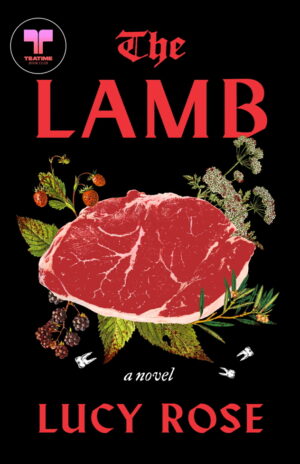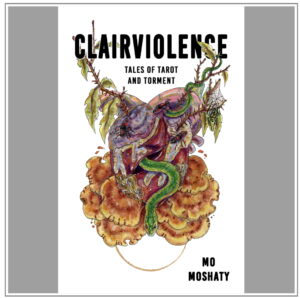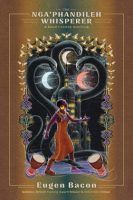The Seers’ Table, August 2025
Kari J. Wolfe, Member of the Diverse Works Inclusion Committee
You can see any of The Seers’ Table posts since inception (March 2016) by going to the HWA main page and selecting the menu item “HWA Publications / Blogs / Seers’ Table”.
Nicole D. Sconiers recommends:
 Lucy Rose is an author and award-winning writer/director with an interest in the gothic, girlhood, and horror. Her fiction and nonfiction have been published in Dread Central, Mslexia, and other publications.
Lucy Rose is an author and award-winning writer/director with an interest in the gothic, girlhood, and horror. Her fiction and nonfiction have been published in Dread Central, Mslexia, and other publications.
Rose’s films have visited BAFTA- and Oscar-qualifying film festivals internationally. She is also a Forbes 30 Under 30 Europe class of 2025. She lives on the northeast coast of England with her black cat, Figgy, and is currently working on her next book. The Lamb is her first novel.
In The Lamb, Margot and Ruth aren’t your typical mother and daughter. They’re cannibals who live in the woods. They feast on strangers whose cars break down or who get lost and stumble upon their cottage seeking help. Strays, Ruth calls them.
Although blood and bruises are a normal way of life in Margot’s household, she starts to question her bizarre hunger and her mother’s inability to love. When a beautiful stray named Eden arrives at their door during a snowstorm, Margot realizes the body count’s about to rise yet again. But will she be the one consumed?
The Lamb is an unforgettable queer coming-of-age tale that serves up a terrifying twist on mother-daughter relationships and examines how women are often forced to swallow their feelings and desires to gain acceptance.
Recommended reading: The Lamb: A Novel (HarperCollins, 2025)
Excerpt from The Lamb:
 My skin was greying. The blood in my body was hiding.
My skin was greying. The blood in my body was hiding.
I woke up coughing, curled up on the floor in a mouldy corner of the room. In my sleep, I’d pulled a sheet down from the bed and snuggled up inside. It smelt like Mama.
When I looked out the window, Mama was sitting in the mud, head in her hands as she stared into an empty ditch. Eden fetched an old jumper from inside and put it over Mama’s shoulders, kissing her forehead. Nearby, a small pile of bones and clothes had been gathered from Eden’s search of the woodland. There were still body parts and trinkets left to uncover along the woodland pathways. Eden wouldn’t stop until they were all buried in the cold ground again. A gale brushed past them both and tickled the bottoms of their dresses, kicking up the hems to cool off their thighs.
Mama looked up, catching me at the window. I searched her expression for something familiar, but I didn’t recognise the woman standing in our garden. It’s impossible to truly know someone who hides so much of themselves and consumes so much of others.
Over the years, I’d watched her pick up pieces of strays and wear them; weave them into her personality. Dresses. T-shirts. Nail polish. Jewellery. Bags. Shoes. Even lingerie. Everything and anything she could take to fill the hungry void. Now she was unravelling, because at the centre of it all there was nothing keeping her together.
Follow Lucy Rose on Instagram: @lucyrosecreates
Kate Maruyama recommends:
 Sanjana Sekhar is a South Indian-American Author, filmmaker, and narrative strategist.
Sanjana Sekhar is a South Indian-American Author, filmmaker, and narrative strategist.
With an eye to strategic communication and systems-thinking storytelling, her work crafts “thrutopian” stories aimed at making climate action the hottest place to be. Lensed with climate justice, radical imagination, and adrienne maree brown’s “pleasure activism,” Sanjana’s focus is on reclaiming and healing extractive narratives to instead build a healthy human future on Earth. She’s been featured in the Hollywood Climate Summit, Tedx Climate AcrosstheAmericas, and the Webby Honorees, and she’s worked with organizations such as the Center for Cultural Power, Visit California, and The Washington Post. Sanjana’s first feature documentary Expedition Reclamation follows twelve everyday Black, Indigenous, and women of color redefining “outdoorsy” and reclaiming belonging in outdoor recreation. It was awarded Best in Festival at the 2022 No Man’s Land Film Festival. The film has screened in 15+ festivals, along the way also winning Best Climate Documentary and Best Environmental Film, and in over 40 community screenings around the country. As the founder of creative studio GARMI, Sanjana is currently bringing her climate communication into auto-ethnographic newsletters, speculative fiction, music, and more. Her latest short story “Cabbage Koora: A Prognostic Autobiography” was a winner of Grist’s Imagine 2200 Climate Fiction Contest, in partnership with the NRDC, and is published in the cli-fi anthology Metamorphosis.
Sekhar lives in Los Angeles on Tongva Land
Recommended Reading: “Cabbage Koora” which appears on Grist.
 Then I moved away from my mother, starting a life in L.A. in community with other South Asian storytellers who were committed to drawing attention to climate and culture. Those of us who’d joined the movement as soon as we became conscious of it saw the writing on the wall long back, but it took the bubble actually popping around the wealthy for those in power to take any real action on what was going on.
Then I moved away from my mother, starting a life in L.A. in community with other South Asian storytellers who were committed to drawing attention to climate and culture. Those of us who’d joined the movement as soon as we became conscious of it saw the writing on the wall long back, but it took the bubble actually popping around the wealthy for those in power to take any real action on what was going on.
In L.A., most of the mansions in the hills got wiped out by fires long ago. A staccato of winter storms caused irreparable mudslides along Mulholland Drive. The Pacific Ocean claimed Santa Monica. The city was forced to implement retreat strategies, which led to them regulating lot sizes as more people had to relocate to the livable areas of L.A. Predictably, some millionaires really fought against this and did everything they could to rebuild their mansions and add “climate-protective measures,” but no one ever got too far in the process because insurance companies no longer cover houses built in long-designated Hazard Zones, and after a certain point with all the carbon taxes levied on any building project that exceeds Reciprocal Resourcing Standards, the mansions were no longer financially viable. Other millionaires were shockingly supportive of the lot size restrictions, and wound up working within Reciprocal Resourcing Standards to build sustainable collectives.
Of course, some people still went the route of save-myself-at-the-expense-of-others. They built bunkers with the goal of “self-sufficiency.” It’s a seductive idea, until you realize what it means is isolation from any sense of community. We are by definition interdependent. Our survival is predicated on our ability to work together.
You can follow Sanjana on Instagramand learn more about her here
Linda D. Addison recommends:
 Mo Moshaty is a horror writer, lecturer, and producer whose work fuses genre storytelling with sharp cultural insight. As Founder and Editor-in-Chief of NightTide Magazine and head of Mourning Manor Media, Mo has carved a space for historically marginalized voices in horror, championing the stories of Creators of Color, LGBTQIA+ communities, neurodivergent creatives, and those challenging ageism within the genre. She is a multi-award-winning author and filmmaker, with her short 13 MINUTES OF HORROR: SCI-FI HORROR winning the 2022 Rondo Hatton Classic Horror Award for Best Short Film.
Mo Moshaty is a horror writer, lecturer, and producer whose work fuses genre storytelling with sharp cultural insight. As Founder and Editor-in-Chief of NightTide Magazine and head of Mourning Manor Media, Mo has carved a space for historically marginalized voices in horror, championing the stories of Creators of Color, LGBTQIA+ communities, neurodivergent creatives, and those challenging ageism within the genre. She is a multi-award-winning author and filmmaker, with her short 13 MINUTES OF HORROR: SCI-FI HORROR winning the 2022 Rondo Hatton Classic Horror Award for Best Short Film.
Mo has collaborated with Shudder and Stowe Story Labs to develop opportunities for underrepresented filmmakers, and she has been recognized as part of the Black Women in Horror Class of 2023. Her lectures on women’s trauma in horror cinema and the intersections of fear, folklore, and identity have taken her to international stages in the US, UK, Germany, Italy, and beyond.
Her debut novella, Love the Sinner, was released in 2023, followed by her highly anticipated collection Clairviolence: Tales of Tarot and Torment, launching October 21, 2025, with Tenebrous Press. Looking ahead, Mo will release The Annex of the Obscure, Vol. 1: The Afterlife in 2026, a nonfiction exploration of grief, burial traditions, and our global need to believe in what lies beyond.
Recommended Reading: Clairviolence: Tales of Tarot and Torment (Tenebrous Press, October 21, 2025)
Excerpt from The Fever Man, the tale opens a couple in the hospital, the wife in labor, and the terrible things that happens when the shadow of a man appears, taking us on a ride through darkness full of twists and turns:
 ‘The man in my dream. Every time is the same. I start the seedlings in the shed. I water them and grab the flats to stick in the greenhouse. And he’s there.’ Pam straightened and sat up on one elbow. I reached out to steady her.
‘The man in my dream. Every time is the same. I start the seedlings in the shed. I water them and grab the flats to stick in the greenhouse. And he’s there.’ Pam straightened and sat up on one elbow. I reached out to steady her.
‘What did he look like?’ I asked.
‘Like nothing?’
‘Nothing?’ Pulling the anger out of my voice was getting harder.
Fuck’s sake pull yourself together man.
‘Like nothing, static, I don’t know. You could see through him, but he was darkersome how, like a shadow. Just standing there, like a liquid in the middle of the yard between the shed and the house. I would walk to the left and he would move there too. Then I would go right, and he would move too. Just wouldn’t let me pass.’
‘That’s terrible.’ My mouth was horrifically dry, and that was all I could muster.
‘And then I’d wake up and I’d have this weird sort of haze at the corner of my eye and then I’d close my eyes, and it’d go away. Just like that. Every night.’
‘Like a grey blob?’ Her eyes widened in panic, and she turned her head quickly back to the hospital window and watched the light drops of rain that began to kiss the glass.
Follow Moshaty at website: https://www.momoshaty.com/ ; Instagram: momoshaty; BluSky: momoshaty.bsky.social



